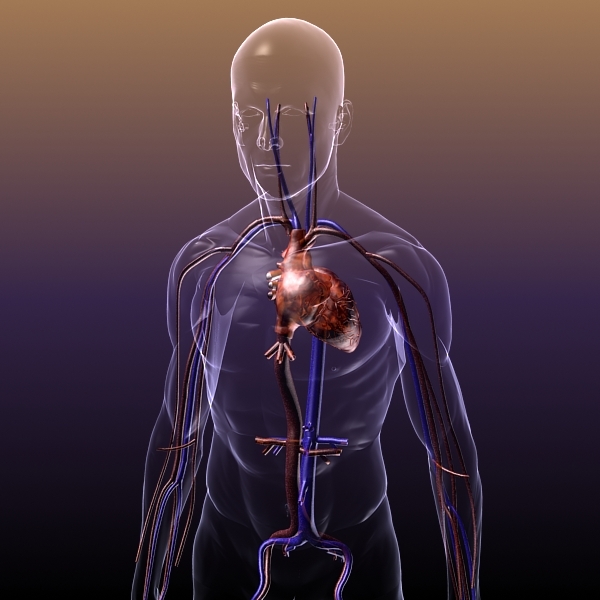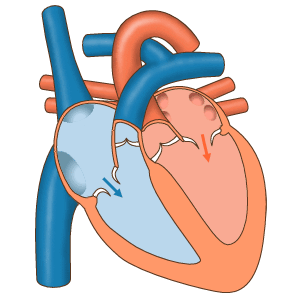 The circulatory system, also called the cardiovascular system or the vascular system, is an organ system that permits blood to circulate and transport nutrients (such as amino acids and electrolytes), oxygen, carbon dioxide, hormones, and blood cells to and from the cells in the body to provide nourishment and help in fighting diseases, stabilize temperature and pH, and maintain homeostasis. The study of the blood flow is called hemodynamics. The study of the properties of the blood flow is called hemorheology.
The circulatory system, also called the cardiovascular system or the vascular system, is an organ system that permits blood to circulate and transport nutrients (such as amino acids and electrolytes), oxygen, carbon dioxide, hormones, and blood cells to and from the cells in the body to provide nourishment and help in fighting diseases, stabilize temperature and pH, and maintain homeostasis. The study of the blood flow is called hemodynamics. The study of the properties of the blood flow is called hemorheology.
The circulatory system is often seen to comprise two separate
systems: the cardiovascular system, which distributes blood, and the lymphatic system, which circulates lymph. The passage of lymph for example takes much longer than that of blood. Blood is a fluid consisting of plasma, red blood cells, white blood cells, and platelets that is circulated by the heart
through the vertebrate vascular system, carrying oxygen and nutrients
to and waste materials away from all body tissues. Lymph is essentially
recycled excess blood plasma after it has been filtered from the interstitial fluid
(between cells) and returned to the lymphatic system. The
cardiovascular (from Latin words meaning "heart" and "vessel") system
comprises the blood, heart, and blood vessels. The lymph, lymph nodes, and lymph vessels form the lymphatic system, which returns filtered blood plasma from the interstitial fluid (between cells) as lymph.
While humans, as well as other vertebrates, have a closed cardiovascular system (meaning that the blood never leaves the network of arteries, veins and capillaries), some invertebrate
groups have an open cardiovascular system. The lymphatic system, on the
other hand, is an open system providing an accessory route for excess
interstitial fluid to be returned to the blood. The more primitive, diploblastic animal phyla lack circulatory systems read more.
 Human Blood
Human Blood
Blood is a bodily fluid in humans and other animals that delivers necessary substances such as nutrients and oxygen to the cells and transports metabolic waste products away from those same cells.[1] When it reaches the lungs, gas exchange occurs when carbon dioxide is diffused out of the blood into the pulmonary alveoli and oxygen is diffused into the blood. This oxygenated blood is pumped to the left hand side of the heart in the pulmonary vein and enters the left atrium. From here it passes through the mitral valve, through the ventricle and taken all around the body by the aorta. Blood contains antibodies, nutrients, oxygen and much more to help the body work.
Cells
One microliter of blood contains:
- 4.7 to 6.1 million (male), 4.2 to 5.4 million (female) erythrocytes:[6] Red blood cells contain the blood's hemoglobin and distribute oxygen. Mature red blood cells lack a nucleus and organelles in mammals. The red blood cells (together with endothelial vessel cells and other cells) are also marked by glycoproteins that define the different blood types. The proportion of blood occupied by red blood cells is referred to as the hematocrit, and is normally about 45%. The combined surface area of all red blood cells of the human body would be roughly 2,000 times as great as the body's exterior surface.[7]
- 4,000–11,000 leukocytes:[8] White blood cells are part of the body's immune system; they destroy and remove old or aberrant cells and cellular debris, as well as attack infectious agents (pathogens) and foreign substances. The cancer of leukocytes is called leukemia.
- 200,000–500,000 thrombocytes:[8] Also called platelets, they take part in blood clotting (coagulation). Fibrin from the coagulation cascade creates a mesh over the platelet plug.
Plasma
About 55% of blood is blood plasma,
a fluid that is the blood's liquid medium, which by itself is
straw-yellow in color. The blood plasma volume totals of 2.7–3.0 liters
(2.8–3.2 quarts) in an average human. It is essentially an aqueous solution containing 92% water, 8% blood plasma proteins, and trace amounts of other materials. Plasma circulates dissolved nutrients, such as glucose, amino acids, and fatty acids (dissolved in the blood or bound to plasma proteins), and removes waste products, such as carbon dioxide, urea, and lactic acid.
Other important components include:
- Serum albumin
- Blood-clotting factors (to facilitate coagulation)
- Immunoglobulins (antibodies)
- lipoprotein particles
- Various other proteins
- Various electrolytes (mainly sodium and chloride)
The term serum refers to plasma from which the clotting proteins have been removed. Most of the proteins remaining are albumin and immunoglobulins.
pH values
Blood pH is regulated to stay within the narrow range of 7.35 to 7.45, making it slightly basic.[9][10] Blood that has a pH below 7.35 is too acidic, whereas blood pH above 7.45 is too basic. Blood pH, partial pressure of oxygen (pO2), partial pressure of carbon dioxide (pCO2), and HCO3− are carefully regulated by a number of homeostatic mechanisms, which exert their influence principally through the respiratory system and the urinary system in order to control the acid-base balance and respiration. An arterial blood gas test will measure these. Plasma also circulates hormones transmitting their messages to various tissues. The list of normal reference ranges for various blood electrolytes is extensive read more.
Red blood cell
The cytoplasm of erythrocytes is rich in hemoglobin, an iron-containing biomolecule that can bind oxygen and is responsible for the red color of the cells. The cell membrane is composed of proteins and lipids, and this structure provides properties essential for physiological cell function such as deformability and stability while traversing the circulatory system and specifically the capillary network.
In humans, mature red blood cells are flexible and oval biconcave disks. They lack a cell nucleus and most organelles, in order to accommodate maximum space for hemoglobin; they can be viewed as sacks of hemoglobin, with a plasma membrane as the sack. Approximately 2.4 million new erythrocytes are produced per second in human adults. The cells develop in the bone marrow and circulate for about 100–120 days in the body before their components are recycled by macrophages. Each circulation takes about 20 seconds. Approximately a quarter of the cells in the human body are red blood cells. Nearly half of the blood's volume (40% to 45%) is red blood cells.
Red blood cells are also known as RBCs, red cells, red blood corpuscles, haematids, erythroid cells or erythrocytes (from Greek erythros for "red" and kytos for "hollow vessel", with -cyte translated as "cell" in modern usage). Packed red blood cells (pRBC) are red blood cells that have been donated, processed, and stored in a blood bank for blood transfusion read more.
White blood cells (WBCs)
White blood cells (WBCs), also called leukocytes or leucocytes, are the cells of the immune system that are involved in protecting the body against both infectious disease and foreign invaders. All white blood cells are produced and derived from a multipotent cell in the bone marrow known as a hematopoietic stem cell. Leukocytes are found throughout the body, including the blood and lymphatic system.All white blood cells have nuclei, which distinguishes them from the other blood cells, the anucleated red blood cells (RBCs) and platelets. Types of white blood cells can be classified in standard ways. Two pairs of broadest categories classify them either by structure (granulocytes or agranulocytes) or by cell division lineage (myeloid cells or lymphoid cells). These broadest categories can be further divided into the five main types: neutrophils, eosinophils, basophils, lymphocytes, and monocytes. These types are distinguished by their physical and functional characteristics. Monocytes and neutrophils are phagocytic. Further subtypes can be classified; for example, among lymphocytes, there are B cells, T cells, and NK cells.
The number of leukocytes in the blood is often an indicator of disease, and thus the WBC count is an important subset of the complete blood count. The normal white cell count is usually between 4 and 11 × 109/L. In the US this is usually expressed as 4,000–11,000 white blood cells per microliter of blood. They make up approximately 1% of the total blood volume in a healthy adult, making them substantially less numerous than the RBCs at 40% to 45%. However, this 1% of the blood makes a large difference to health, because immunity depends on it. An increase in the number of leukocytes over the upper limits is called leukocytosis. It is normal when it is part of healthy immune responses, which happen frequently. It is occasionally abnormal, when it is neoplastic or autoimmune in origin. A decrease below the lower limit is called leukopenia. It weakens the immune system Read more.
Serum
Serum is a clear, yellowish coloured fluid which is part of the blood. It does not contain white or red blood cells or a clotting factor. It is the blood plasma without the fibrinogens. Serum includes all proteins not used in blood clotting (coagulation) and all the electrolytes, antibodies, antigens, hormones, and any extra substances such as drugs and microorganisms).The study of serum is serology. Serum is used in many medical diagnostic tests, as well as in blood typing.
Blood is centrifuged to remove cellular components. Anti-coagulated blood yields plasma containing fibrinogen and clotting factors. Coagulated blood (clotted blood) yields serum without fibrinogen, although some clotting factors remain.
Serum is an important part of the self-renewal of embryonic stem cells when combined with the cytokine leukemia inhibitory factor Read more.
Heart
 The heart is a muscular organ in humans and other animals, which pumps blood through the blood vessels of the circulatory system. Blood provides the body with oxygen and nutrients, and also assists in the removal of metabolic wastes. The heart is located in the middle compartment of the mediastinum in the chest.
The heart is a muscular organ in humans and other animals, which pumps blood through the blood vessels of the circulatory system. Blood provides the body with oxygen and nutrients, and also assists in the removal of metabolic wastes. The heart is located in the middle compartment of the mediastinum in the chest.In humans, other mammals, and birds, the heart is divided into four chambers: upper left and right atria; and lower left and right ventricles.[4][5] Commonly the right atrium and ventricle are referred together as the right heart and their left counterparts as the left heart. Fish in contrast have two chambers, an atrium and a ventricle, while reptiles have three chambers. In a healthy heart blood flows one way through the heart due to heart valves, which prevent backflow. The heart is enclosed in a protective sac, the pericardium, which also contains a small amount of fluid. The wall of the heart is made up of three layers: epicardium, myocardium, and endocardiumread more.
